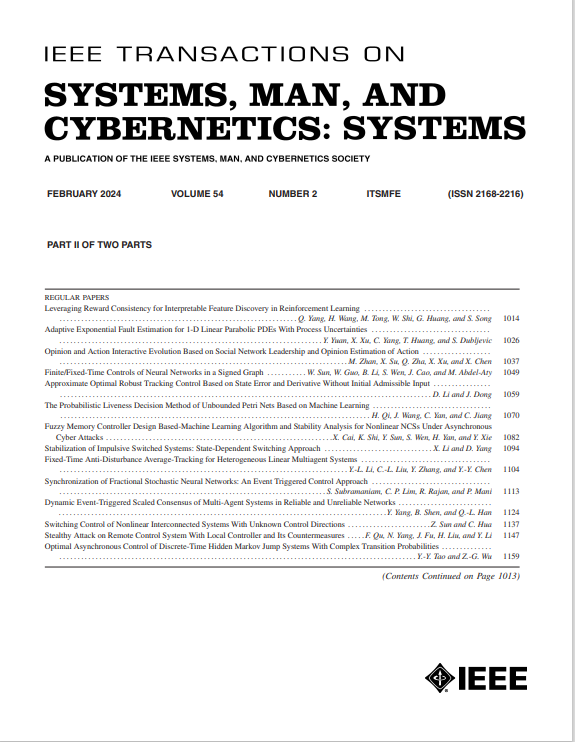AKDC: Ambiguous Kernel Distance Clustering Algorithm for COVID-19 CT Scans Analysis
IF 8.6
1区 计算机科学
Q1 AUTOMATION & CONTROL SYSTEMS
IEEE Transactions on Systems Man Cybernetics-Systems
Pub Date : 2024-07-23
DOI:10.1109/TSMC.2024.3418411
引用次数: 0
Abstract
Conventional soft clustering algorithms perform well on linearly distributed features, but their performance degrades on nonlinearly distributed features in high-dimensional space. In this study, a novel soft clustering algorithm, the ambiguous kernel distance clustering (AKDC) algorithm, is presented. This algorithm is developed by applying ambiguous set theory and the Gaussian kernel function. The ambiguous set theory defines the ambiguities inherent in each feature with four membership values: 1) true; 2) false; 3) true-ambiguous; and 4) false-ambiguous. The degree of membership values here forms a low-dimensional feature space that is not linearly distributed. Therefore, these nonlinearly distributed membership values are mapped into a high-dimensional feature space using the Gaussian kernel function. This study focuses on performing cluster analysis of computerized tomography scans of COVID-19 (CTSC-19) cases using AKDC. COVID-19, recognized as one of the most life-threatening diseases of this century, is highly contagious, and early diagnosis may prevent one-to-one transmission. Extensive empirical studies have been conducted with different types of CTSC-19 to demonstrate its effectiveness against existing kernel-based clustering and nonkernel-based clustering algorithms, namely mercer kernel fuzzy c-mean (MKFCM), kernel generalized FCM (KGFCM), kernel intuitionistic fuzzy entropy c-means (KIFECMs), morphological reconstruction and membership filtering clustering (FRFCM), and intuitionistic FCM based on membership information transferring and similarity measurements (IFCM-MS). The effectiveness of the proposed algorithm compared to the existing algorithms is evaluated using standard statistical metrics, such as dice index (DI), Jaccard index (JI), structural similarity index (SI), and correlation coefficient (CC). The empirical results show that AKDC is more effective than existing algorithms based on DI, JI, SI, and CC.AKDC:用于 COVID-19 CT 扫描分析的模糊核距离聚类算法
传统的软聚类算法在线性分布的特征上表现良好,但在高维空间的非线性分布特征上性能下降。本研究提出了一种新型软聚类算法--模糊核距离聚类(AKDC)算法。该算法是应用模糊集理论和高斯核函数开发的。模糊集理论用四个成员值定义了每个特征的内在模糊性:1)真;2)假;3)真-模糊;4)假-模糊。这里的成员值程度形成了一个非线性分布的低维特征空间。因此,使用高斯核函数将这些非线性分布的成员值映射到高维特征空间中。本研究的重点是使用 AKDC 对 COVID-19(CTSC-19)病例的计算机断层扫描进行聚类分析。COVID-19 被认为是本世纪最危及生命的疾病之一,具有高度传染性,早期诊断可防止一对一传播。对不同类型的 CTSC-19 进行了广泛的实证研究,以证明其在与现有的基于核的聚类算法和非核聚类算法(即梅克尔核模糊 c-mean (MKFCM))进行比较时的有效性、内核广义 FCM(KGFCM)、内核直觉模糊熵 c-均值(KIFECMs)、形态重建和成员过滤聚类(FRFCM)以及基于成员信息转移和相似性测量的直觉 FCM(IFCM-MS)。使用标准统计指标,如骰子指数(DI)、雅卡指数(JI)、结构相似性指数(SI)和相关系数(CC),评估了所提算法与现有算法相比的有效性。实证结果表明,AKDC 比基于 DI、JI、SI 和 CC 的现有算法更有效。
本文章由计算机程序翻译,如有差异,请以英文原文为准。
求助全文
约1分钟内获得全文
求助全文
来源期刊

IEEE Transactions on Systems Man Cybernetics-Systems
AUTOMATION & CONTROL SYSTEMS-COMPUTER SCIENCE, CYBERNETICS
CiteScore
18.50
自引率
11.50%
发文量
812
审稿时长
6 months
期刊介绍:
The IEEE Transactions on Systems, Man, and Cybernetics: Systems encompasses the fields of systems engineering, covering issue formulation, analysis, and modeling throughout the systems engineering lifecycle phases. It addresses decision-making, issue interpretation, systems management, processes, and various methods such as optimization, modeling, and simulation in the development and deployment of large systems.
 求助内容:
求助内容: 应助结果提醒方式:
应助结果提醒方式:


